Shared remembrance of the Second World War
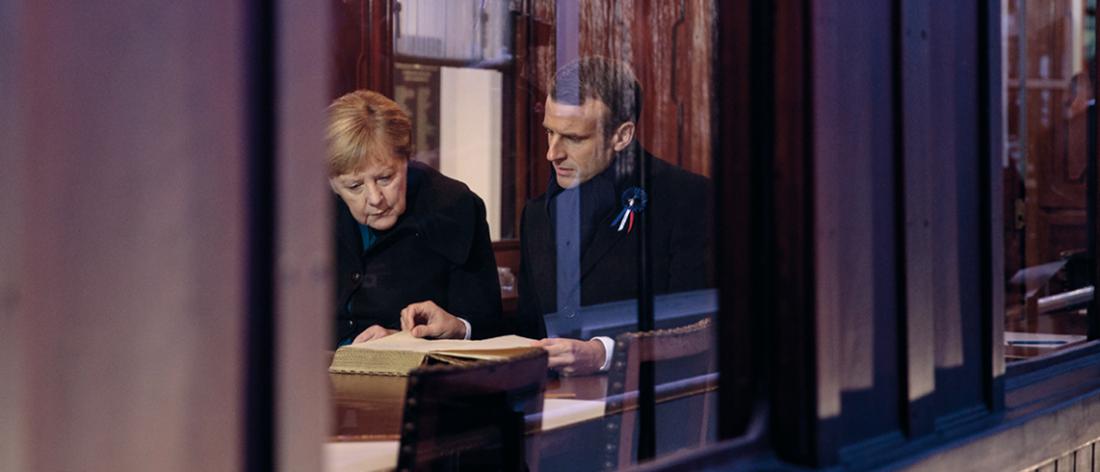
If the First World War centenary was quite clearly a Franco-German commemoration, this not so self-evident when it came to the Second World War. After several decades of hesitant gestures, France and Germany gave concrete expression to their reconciliation, namely with the remembrance of 6 June.
Like their remembrance, the commemorative dates of the two world wars overlap and clash. As a result, while the ceremonies may resemble one another – those of the Second World War being modelled on those devised for the Great War – remembrance of the two conflicts is not identical. The difference does not depend only on their remoteness in time, but has to do with the specific character of the Second World War and the crimes against humanity for which it was the setting. Whereas the First World War can be framed as a story of soldiers who fought bravely in extreme conditions for their respective countries, the Second World War is not so easy to digest. In France, references to the Resistance and de Gaulle’s call to arms covered up the defeat and, for a long time, collaboration. In Germany, since the 1970s, and in increasingly strong terms, its remembrance has been an opportunity to acknowledge the crimes committed, honour the memory of the victims and highlight the collective responsibility of the German people.
But it is far from easy for Germans and French to remember these two wars together, particularly the Second World War. It is the expression of a joint political will to overcome these conflicts in the name of a common future embodied in European integration.
The difficulties of shared commemorations
In fact, the situation between France and Germany is deeply asymmetrical: across the Rhine, no commemorative tradition has grown up around either 11 November or 8 May. In the early 1950s, the Volkstrauertag remembrance day, instituted at the request of veterans and commemorated in the spring under the Weimar Republic, then by the name of “Heroes’ Day” under the Third Reich, was moved to a Sunday in November. There is no federal law laying down its precise content. However, some Länder do refer explicitly, as well as to the soldiers killed, to the victims of national socialism, who over the years have taken on increasing importance. But the 11 November remains first and foremost the first day of carnival in the Rhineland. Meanwhile, 8 May was a public holiday in the GDR from 1950 to 1967. It became one once again in 2002, in the reunified Germany, in the Land of Mecklenburg-Vorpommern. It was a public holiday in Berlin in 2021 for the 75th anniversary of VE Day, and there were petitions, in a context of the rise of the far right, calling for its inclusion in the national commemorative calendar. It was 8 May that Richard von Weizsäcker, president of the Federal Republic of Germany, chose in 1985 to describe in a speech to the Bundestag as a day of “liberation”: “It is [...] a day of reflection on the course of our history. [...] This day liberated us all from the system of national-socialist tyranny built on a contempt for human beings. [...] Today, we evoke that human suffering and remember them in grief. [...] We must understand that there can be no reconciliation without remembrance.” This position is far from unanimous. Without seeking to ignore it, Konrad Adenauer said that “the past should be left to the past”. Helmut Kohl showed little more enthusiasm. Publications, or revelations about the past of a particular leader, regularly sparked controversy in the public arena about this “ever-present past”. How to combine the acknowledgment of Nazi war crimes with the reconstruction of national pride? How to distinguish between the soldiers “who did their duty” and the SS? What place should be given to those who fought the regime?
On the French side, too, remembering the wars with the Germans has at times prompted hostile reactions. In 2004, Michèle Alliot-Marie, the French Minister of Defence at the time, acknowledged in an interview with German TV channel ARD that despite “the bonds forged [...] in particular in terms of partnerships and town twinnings between the former protagonists [...] there nevertheless remains an awkwardness, a kind of unease, between the protagonists”.
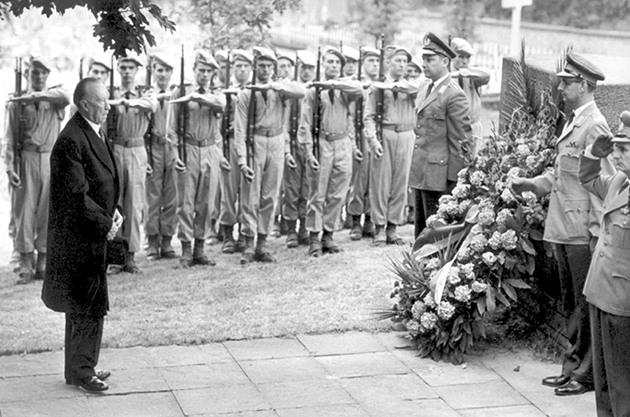
On an official visit to France, Chancellor Konrad Adenauer lays a wreath at the memorial to the
victims of the Second World War, Versailles, 5 July 1962. © akg-images/picturealliance/dpa
One of the strategies employed to make reconciliation possible was to reduce the Second World War to a conflict between nations, in which both sides showed heroism and courage: “Of so much blood and tears, nothing should be forgotten. For however ill-founded the immediate motives of our wars, however regrettable their processes, however ruinous their outcomes, deep down a great cause was the source of our quarrels,” declared Charles de Gaulle in his toast to Konrad Adenauer on 3 July 1962. François Mitterrand said the same thing to the Bundestag on 9 May 1995, to the great displeasure of a sector of German public opinion: “It matters little the uniform, or even the thoughts in the heads, of these soldiers who would die in such large numbers. They were brave. They accepted losing their lives. It may have been for the wrong cause, but their own acts had nothing to do with that. They loved their country.”
If de Gaulle was reserved about a Franco-German remembrance of the two wars, preferring to celebrate the reconciliation at occasions other than the national rituals, Valéry Giscard d’Estaing did away with the 8 May commemorations altogether. “Each of us shall have our own memories and remember those who deserve to be remembered. But it is time to pave the way for the future and turn our thoughts to what brings us together and what can unite us,” he wrote to European leaders on 10 May 1975. For him, history was a burden that must be lightened in order to move forward. The storm of criticism prompted by this decision, at a time when the issue of remembrance was taking up a new place in Western societies, signalled that policies of amnesia were no longer an option.
The 6th June, or the paths of shared remembrance
By raising the question of whether or not Germany, a driving force of European integration, should be among the guests, the commemorations of the Normandy landings of 6 June 1944 played a crucial role in instituting a joint Franco-German act of remembrance.
The first major D-Day commemorations were in 1984. In 1964, de Gaulle had chosen to focus on the Provence landings. In 1974, Giscard had made no particular arrangements. François Mitterrand, on the other hand, decided to make it a high point of his diplomacy. The principal heads of state and government of the Allied Western nations of 1944 took part. The Germans were not invited. Nor were they in 1994. Mitterrand came under fire from part of the press for this absence, but it was Helmut Kohl who did not wish to take part, for reasons both political – the fear of being misunderstood by his electorate – and personal – his brother was killed in Normandy: “This is not the time for a German chancellor to celebrate, when others are commemorating their victory in a battle in which tens of thousands of Germans lost their lives,” he told Der Spiegel in 1984. Germany’s absence, and the questions and criticisms it prompted, led Mitterrand to invite Kohl to Verdun on 22 September 1984, for what was to be the first major Franco-German commemoration of a war. It may not yet have been possible for the Second World War, but it was for the First.
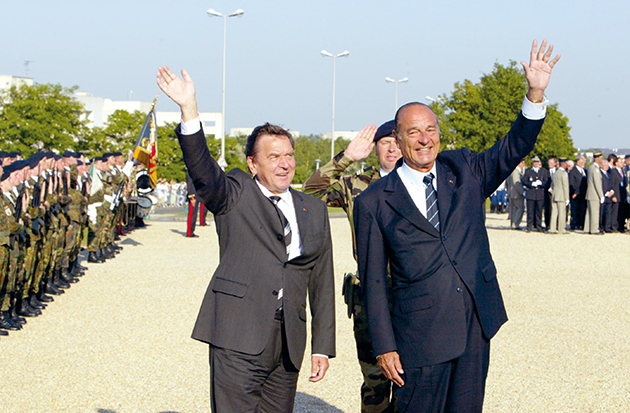
French president Jacques Chirac and German chancellor Gerhard Schröder together commemorate the 60th anniversary of the D-Day landings, 6 June 2004. © Abaca Press/Alamy Stock Photo
It was not until 2004 that a German chancellor, Gerhard Schröder, would visit Normandy to remember the D-Day landings, and stand with Jacques Chirac, before the peace memorial in Caen, to honour the Allied soldiers killed in the fighting, to whom the Germans, as he put it, should be “thankful that they live today in freedom and peace”. “A German chancellor, hand in hand with the victors of the Second World War, on this bloody anniversary. Ten years ago, it would have been sensitive; twenty years ago, a provocation; thirty years ago, it would have been unthinkable. Today, it is possible,” said Der Spiegel. Germany may not have been present at all the ceremonies, but space is devoted to its soldiers in the official speeches. On 6 June 2009, for instance, Nicolas Sarkozy compared an American and German soldier’s traumatic memories of D-Day.
The refound brotherhood of the two countries was at the heart of the ceremony staged on 6 June 2014. Its climax, as the Ode to Joy rang out and the public and heads of state and government applauded, was the arrival at centre stage of two D-Day veterans – one French, Léon Gautier, a member of Kieffer Commando; the other German, Johannes Börner, a paratrooper of the 2nd Corps of the Luftwaffe – who embraced one another. For the first time ever, tribute was paid to a German veteran in the name of a shared future represented by Europe. Although not forgotten, the past was thought to have been overcome: like the other Europeans, the Germans tended to become the victims of Nazism – “All these young Europeans [who lie buried in the cemeteries of Normandy] were victims of Nazi barbarity,” said François Hollande in his speech – and, significantly, the images projected during the ceremony also showed the civilian victims of the Allied bombings, both French and German.
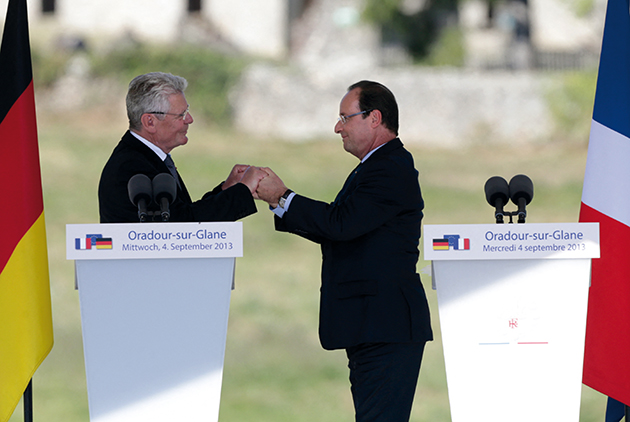
Presidents François Hollande and Joachim Gauck visit Oradour-sur-Glane, 4 September 2013. © AFP
The blueprint of Franco-German remembrance
From Douaumont to the Caen Memorial, whether heads of state and government or veterans, physical contact and shared emotion occupy a central place in the staging of reconciliation, repeated again and again with each ceremony. The risk is for it to become routine and therefore trivialised – which, paradoxically, is a characteristic of all rituals. It is a case, therefore, of seeking a “first time”, to assert the newness of the act. Thus, on 25 August 2006, Angela Merkel and Jacques Chirac laid a wreath at the base of the statue of General de Gaulle to mark the anniversary of the liberation of Paris. In 2009, Nicolas Sarkozy, who had been himself to Berlin on 9 November to celebrate the 20th anniversary of the fall of the Berlin Wall, invited Angela Merkel to the Armistice Day ceremony at the Arc de Triomphe. For the first time, a German head of government rekindled the flame of the Unknown Soldier. “We are gathered here,” she said, “fully conscious of the history which for centuries has connected us, French and Germans, to both happy times and the darkest hours.” On 4 September 2013, François Hollande visited Oradour-sur-Glane with Joachim Gauck, president of the Federal Republic of Germany, to pay tribute to the victims of the massacre perpetrated by the SS – “soldiers obeying German orders,” said Gauck, going on to say that “coming to this place is hard for any German, however much time has passed” and seeing in this invitation “a gesture of reconciliation, a gesture that can never be demanded, but must always be accepted as a gift”. Finally, to keep to only a handful of examples among an ever increasing number, Rethondes was where Emmanuel Macron and Angela Merkel met, on 10 November 2018, in a replica of the railway carriage where the armistice was signed in 1918 and 1940.
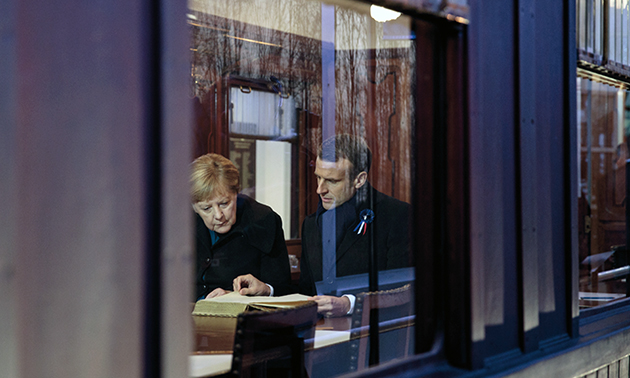
Emmanuel Macron and Angela Merkel commemorate the Armistice of 11 November at Compiègne, in the carriage where it was signed, 10 November 2018.
© Soazig de la Moissonnière/Présidence de la République
Remembrance has a complex alchemy. It is clearly about remembering the past, but always as a function of an anticipated future: remembrance falls not within the sphere of history, but politics. In this case, France and Germany must not allow the past to hinder the future, and must make their reconciliation an element of the narrative of European integration. This is evidently far more difficult for the Second World War. For that reason, to begin with, words and acts of remembrance sought to reduce the Second World War to the First, or to an atavistic confrontation between Germans and Gauls. It was on this basis, of what was not said, that the first gestures of reconciliation were made. As demands for acknowledgement grew, these half-implied expressions were barely tenable any longer. If contemporary Germany is right to be proud of its values, it must accept that the D-Day landings of June 1944 were not an “invasion”, as some describe it across the Rhine, but a liberation, which benefited the Germans of today. Better still, remembering wars has become a way of celebrating the birth of Europe, peace and prosperity. The exemplarity of this reconciliation has become a recurring theme in French and German diplomacy, a blueprint for overcoming the vicissitudes of history – thereby universalising the meaning of Franco-German remembrance.

